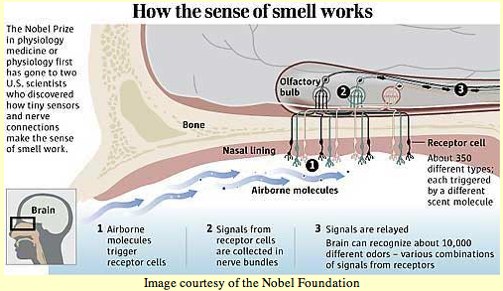
This interactive workshop led by Sheri Sauter Morano, Master of Wine, and hosted by Winebow Wines taught us The Fun Facts behind wine aromas and How to Describe Aromas & Use them in Tastings. If like me, you’ve ever wondered what these scents were all about, read on.
The Fun Facts
When it comes to evaluating wine, our sense of smell is much more acute than our sense of taste. This is helpful as wine contains thousands of scents and only a handful of tastes. But to put it all together you need…
Smell + Taste + Touch
 Smell:Â The receptor cells in our nasal lining (we have 350 different types) collect signals and send them to the olfactory bulb in our brain (the emotional part). The brain can recognize 10,000 different scents. Our sense of smell is hugely influenced by memory. Our ability to identify scents decreases with age, it increases with pregnancy.
Smell:Â The receptor cells in our nasal lining (we have 350 different types) collect signals and send them to the olfactory bulb in our brain (the emotional part). The brain can recognize 10,000 different scents. Our sense of smell is hugely influenced by memory. Our ability to identify scents decreases with age, it increases with pregnancy.
- Taste:Â The receptor cells on our tongue, aka taste buds, react to sweet, sour, bitter, salty and umami (or savory). We have 10,000 taste buds but we don’t all ‘taste’ the same. There are 3 categories of tasters…Supertasters (25% of us), Tasters (50%) and Non-tasters (25%). Taste is genetic. Women have more taste buds than men. Some people are more sensitive to sweet while others more sensitive to bitter.
- Touch: The texture or mouthfeel.
= Flavor!
When tasting wine, we Swirl, Smell, Sip. Swirl to open up the wine, release more of the scents. Smell to take in the scents. Sip…when wine enters the mouth, it mixes with saliva which helps to vaporize the compounds and these compounds are not only tasted but also inhaled exposing more scents to our nasal lining receptor cells. So Smell + Taste + Touch = the Flavor you experience in a wine.
Next we’ll look at How to Describe Aromas & Use them in Tastings. Easier said than done!
* special thanks to Sheri Sauter Morano for sharing her presentation so I could share more with you![/fusion_builder_column][/fusion_builder_row][/fusion_builder_container]
